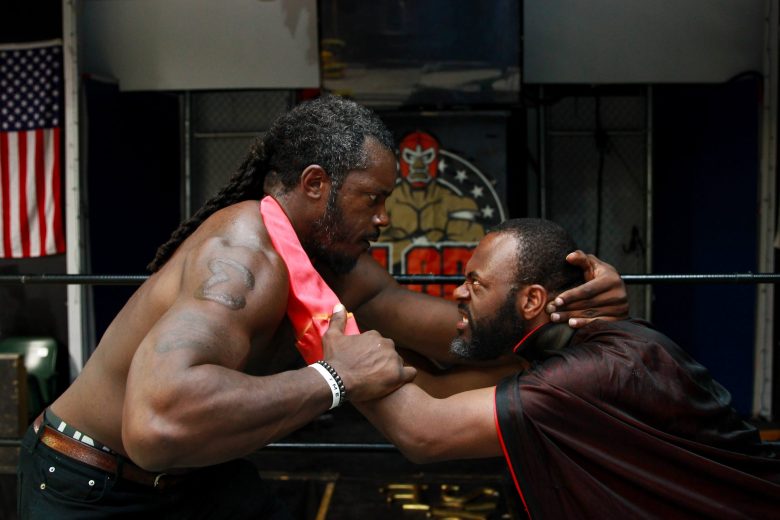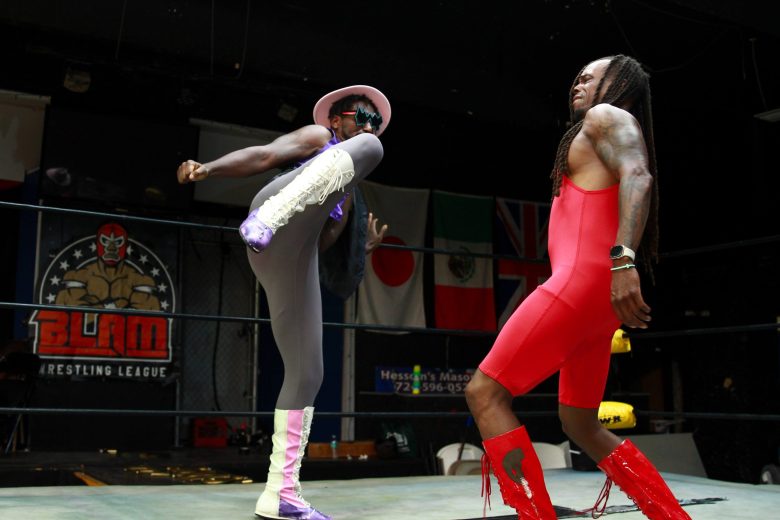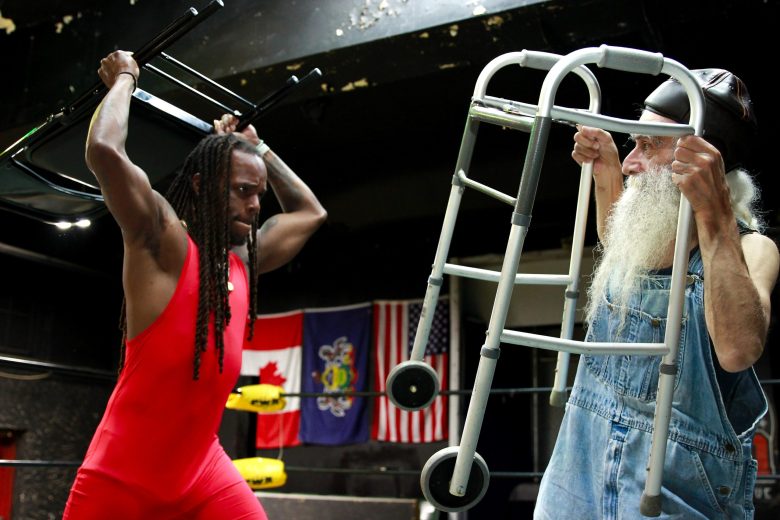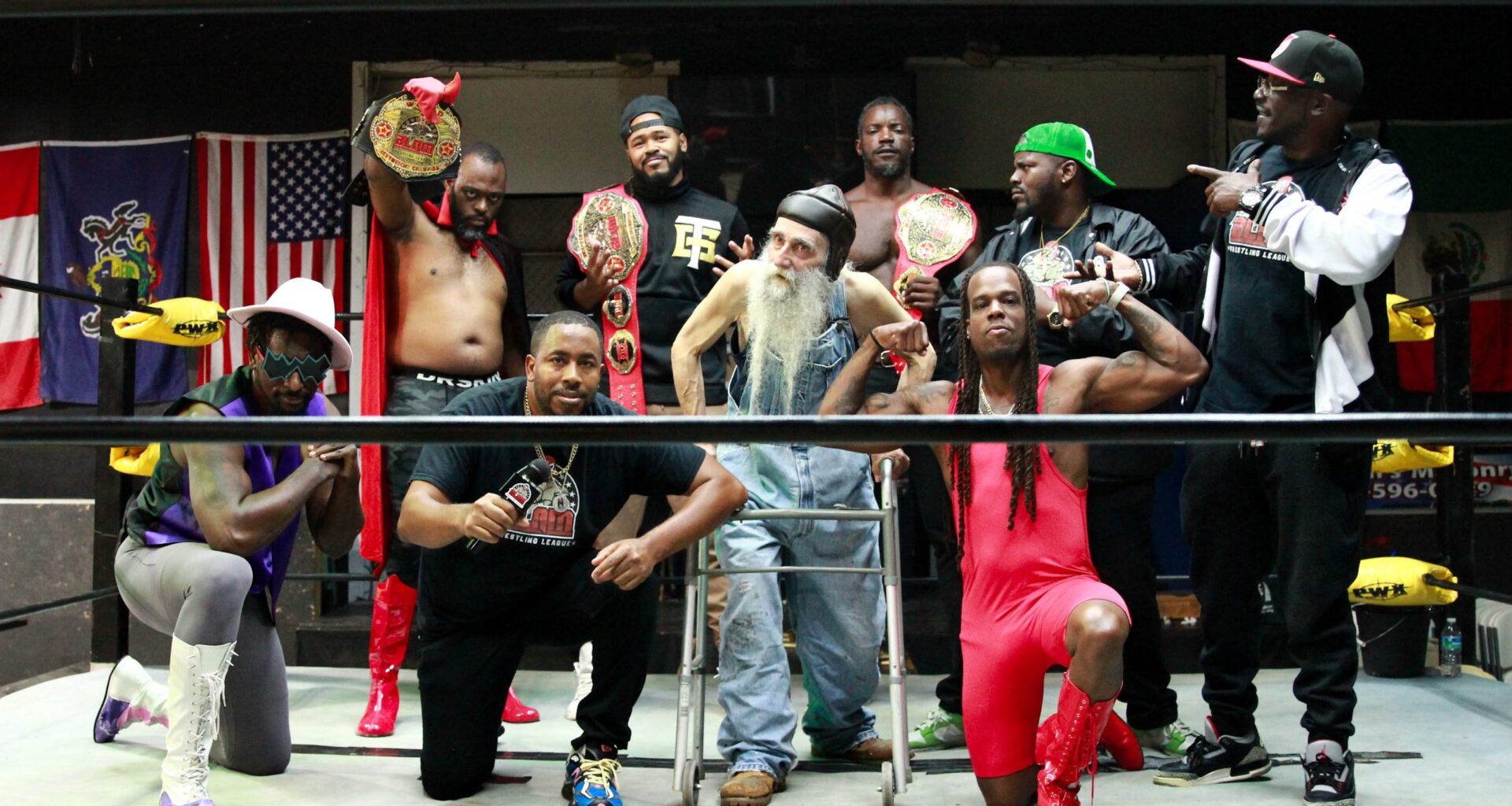“BLAM is an urban term in Pittsburgh for slamming somebody, so I’m not certain if other cities use it. I’m almost certain that they don’t,” says Jay White.
Jay “Ruffbone” White and Tale “Lay Lanskey” Stillwell are in the final stages of editing “BLAM,” a cinematic comedy about a fictional predominantly Black professional wrestling league based in Pittsburgh. In the story, BLAM Wrestling, which began in Pittsburgh years earlier before it went national, returns to the Steel City to recover its lost mojo. Wrestling may be thriving during the Trump era, but BLAM is not.
The gimmick BLAM settles on to generate excitement for the league in its hometown is a $20,000 tournament designed to showcase tag team wrestling at its finest.
“What if you had the opportunity to become a wrestler, not a spectator, and you don’t know anyone who had a chance to become a wrestler?” White says, fleshing out the movie’s premise.
“The two main characters — they’re friends, life is kicking their butts, and they run into a guy at a strip club who used to be in the neighborhood running a wrestling league when they were kids.
One of the characters sees the flyer and decides to get involved for a chance to earn money to become a regional wrestler. “So it’s all about aspiration and following a dream,” says White.
After two-and-a-half years of principal shooting, a yearlong delay while a primary cast member mourned the death of his wife and another equally long delay after Nigel “Nasty Nige” Pryer, one of the film’s stars — died suddenly, “BLAM” is finally in a postproduction sprint having finished all shoots earlier this year.

 Duke Davis, left, “wrestles” GJ Coleman aka Black Lobster. Photo by Rob Liggett.
Duke Davis, left, “wrestles” GJ Coleman aka Black Lobster. Photo by Rob Liggett.
White and Stillwell have dedicated the film to Pryer’s memory. Pryer was one of the film’s experienced studio wrestlers whose expertise the filmmakers constantly drew upon to make the wrestling scenes pop with authenticity. “BLAM” features Pryer’s last performances as the tag team wrestler known as Mr. PerVeCT.
Stillwell and White, both in their mid-40s, are optimistic that they’ll have a polished and very funny movie ready to screen for longtime supporters, crowdfund investors and friends by late spring 2026. The duo doesn’t have local foundation support or the backing of any institution that often funds indie film projects.
White and Stillwell will premiere “BLAM” in Pittsburgh for local supporters even before it is entered in national and international festival competition next year. They expect it to run at a respectable hour and 45 minutes once they’ve cut “BLAM” down to fighting weight.
While “BLAM” reflects Black Pittsburgh’s gallows humor, regional fatalism and stubborn aspiration, it is designed to be relatable to folks who would never consider pierogies a delicacy or order a salad smothered in French fries.
For all of the satisfaction that making “BLAM” has generated for White and Stillwell, who share writing and directing duties on the film, they are mindful of the sacrifices the cast and crew made to realize their vision despite scheduling and budget constraints even after a 2022 crowdfunding campaign generated $10,000 in a month.
Asked how many cast members are just actors pretending to be wrestlers and how many know what they’re doing in the ring, they both laugh.

 Photo by Rob Liggett.
Photo by Rob Liggett.
“We’ve got about 25 wrestlers,” Stillwell, whom White refers to as “Lay” says. “Most of the people in this are first-time actors. It’s a mix of real wrestlers, actors and comedians.
“They’re from Cleveland, Baltimore, Buffalo, Norfolk. We were beyond grateful for what we had because we knew we needed that much to actually make it happen or else it wouldn’t have looked authentic enough and it wouldn’t have carried as much juice as far as wrestling is concerned,” Stillwell says.
While they were able to pay many who worked on the film a pittance of what they deserved, much of the labor in front of the cameras was donated, as were several key sites for scenes in the movie. Some of the shoots stretched on for as long as 14 hours. Sometimes the director/writer duo had to handle sound and light while instructing the actors and framing the shots.
“We had a crew,” White says, “but sometimes we didn’t have enough money to pay everyone, so if they get other gigs that conflict, they do what they have to do to pay the rent or the mortgage.”
White himself does triple duty with a cameo as a referee in the film.
To help ease the production’s monetary shortfall, several businesses went above and beyond what White and Stillwell ever imagined possible when they were storyboarding the film.

 Jaquay Wade aka Sere-Nade prepares to kick T-Doe Rally aka Ran Tan Rally. Photo by Rob Liggett.
Jaquay Wade aka Sere-Nade prepares to kick T-Doe Rally aka Ran Tan Rally. Photo by Rob Liggett.
PWX Wrestling in McKeesport donated its entire gym to the project and allowed the “BLAM” production to cover its facility with the faux wrestling organization’s banners. Both filmmakers were amazed by how easily the aesthetics of the gym corresponded to the requirements of the script even before the movie’s makeover began.
Señor Fries, a popular restaurant on West Liberty Avenue doubled as Finger Lickin’ Fried Chicken for several scenes involving a wrestler who is “addicted to fried chicken.”
Another beloved Pittsburgh site incorporated into the movie is the historic Don’s Diner located under the bridge in the Woods Run section of the North Side — arguably the most unusual restaurant spot in Western Pennsylvania.
In the film, Don’s Diner — which also appeared in Russell Crowe’s “The Next Three Days” and Nick Nolte’s “Warrior” — has been recast as a hot dog shop called Dick’s Dogs with plenty of double entendres thrown in to maintain the film’s comic saltiness.
“BLAM” is chock full of hilariously twisted characters. Take Bishop Backslide, a fake preacher and wrestling Svengali who manages a tag team consisting of one gang member from the Crips and one from the Bloods.
Among their many rivals are Slime Ball Paul, the manager of the Backyard Brawlers. The Wing Dust Winos, a tag team consisting of the Late-Night Nibbler and Terry ‘Ran Tan’ Ralley, are relative good guys in the BLAM lineup compared to the others.

 T-Doe Rally aka Ran Tan Rally goes after Nick Angelou aka Wresslin Ric. Photo by Rob Liggett.
T-Doe Rally aka Ran Tan Rally goes after Nick Angelou aka Wresslin Ric. Photo by Rob Liggett.
There’s also the Jaggernaut Giggolos (the team of Serenade and Mr. PerVeCT), Rasslin’ Rick and the current heavyweight champion, a truly strange character known as the Black Lobster.
“The Black Lobster’s finishing move is called the Lobster Chop,” White says with a laugh. “He hit you with that claw, it’s over.”
The Black Lobster’s name is something of a misnomer since the prosthetic claws he wears are actually red. Still, everything in “BLAM” is mostly Black, especially the humor. That’s the film’s greatest asset. It embraces the absurdities of studio wrestling to tell a distinctly American tale about ambition on the knife’s edge of both failure and redemption.
“We’re grateful for people’s time and what they were able to lend us,” Stillwell says. “The budget was small. A lot of this was done out of love, out of people believing in us.”
From the moment White conceived of a “wrestling comedy with an urban twist” more than five years ago when he and Stillwell were already deep into another project, every day has been dedicated to advancing “BLAM” to the finish line.
“I was watching some old [World Wrestling Federation] wrestling clips,” White says. “It was Randy ‘Macho Man’ Savage and Hulk Hogan doing a hilarious bit in which some invisible magnetic force was preventing them from shaking hands. It was wild.”
He began to wonder why he’s never seen Black wrestlers rise to that iconic level other than Dwayne ‘The Rock’ Johnson who is half Samoan, though arguably the most popular wrestler in the world for much of the last quarter century.

 Photo by Rob Liggett.
Photo by Rob Liggett.
Originally pitched to supporters as a pilot for an ongoing TV series, “BLAM” morphed into a movie once the filming started because of the intricacy and length of the wrestling scenes. Now that it is being shaped into a film, the duo believes there are sequel possibilities if it is well received. They haven’t ruled out making a streaming TV series based on the movie if there’s serious interest in such a project.
Both men are experienced filmmakers, former rappers and local hip-hop promoters. These days, they support themselves and their families working on various media projects and businesses.
White, who has worked on many local documentary projects, runs a multimedia company called Future Stars Media. Stillwell represents up-and-coming hip-hop artists. “BLAM” remains their mutual passion project when they’re not paying the bills.
Having known each other and worked together since they were in their early 20s, Stillwell and White have maintained a deep respect for each other’s talents and figured out early on how to work together with minimum friction.
Asked how the divided duties on “BLAM” to finally get to the postproduction phase, they both exhale, as if recalling a marathon they ran and completed minutes earlier.
“When it comes to writing, [Stillwell] is a rapper,” White said of his business and creative partner. “[Lay] can freestyle off the top of his head. He’s boom-boom-boom!
“He’s talking. I record the conversations. He’s great about how a character needs to sound and how they need to say it, how they’re interpreting it, how they’re coming off with it and their hand gestures,” White says.

 Directer Jay “Ruffbone” White, director Tale Stillwell aka Lay Lanskey, and director of photography Dorin Williams, aka StarrnamedMarr, sit in front of cast members from “BLAM” at PWX Wrestling in McKeesport. Photo by Rob Liggett.
Directer Jay “Ruffbone” White, director Tale Stillwell aka Lay Lanskey, and director of photography Dorin Williams, aka StarrnamedMarr, sit in front of cast members from “BLAM” at PWX Wrestling in McKeesport. Photo by Rob Liggett.
Both White and Stillwell, who grew up in Beltzhoover and Larimar Avenue respectively, keep forging ahead because they’re inspired by the example of Black Pittsburgh filmmakers/directors who made the jump to filmmaking from a city that was far from the Hollywood mainstream.
In a recent Facebook Reel, White did a minute-and-a-half tribute to four cinematic trailblazers from Pittsburgh. “Shout out to the Black film directors from the Burgh who put in work that a lot of people don’t even know is from the city,” he said after saluting Antoine Fuqua, Rusty Cundieff, Ben Ramsey and the late Xavier (Mike) Q. Kantz as exemplars of Pittsburgh’s untamable creative spirit.
It was an impressive list that included a quick mention of each director’s most famous work, many of which would be familiar to anyone who has spent quality time in multiplexes over the last 35 years.
Each of the directors White highlights first dreamed of becoming filmmakers here, but had to leave the city to actualize their dreams. White and Stillwell insist they’re going to buck that trend and remain based in Pittsburgh no matter how big (or little) a success they become as filmmakers.
They’re committed to telling many overlooked stories about America from the city where they learned to dream these stories in the first place.

